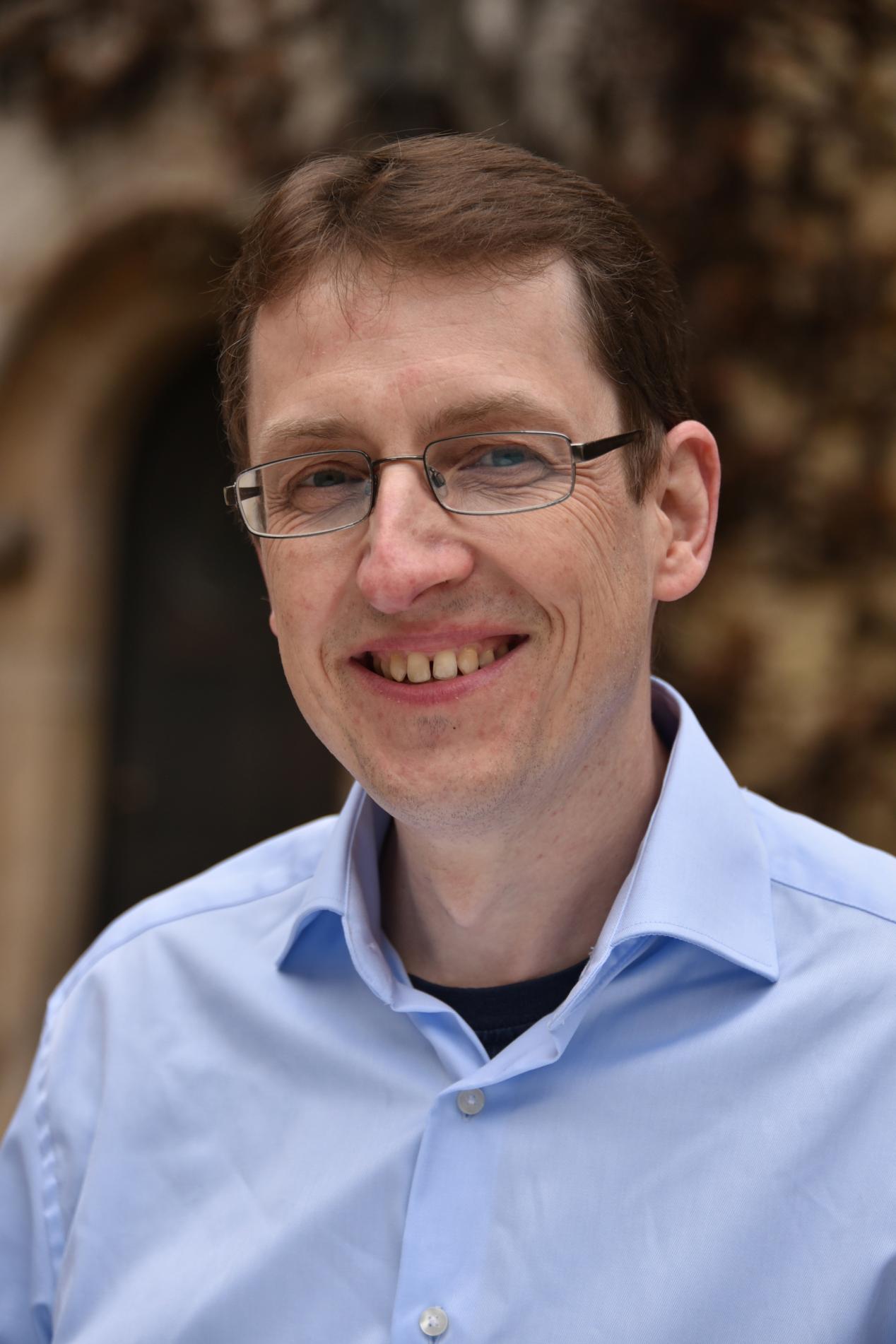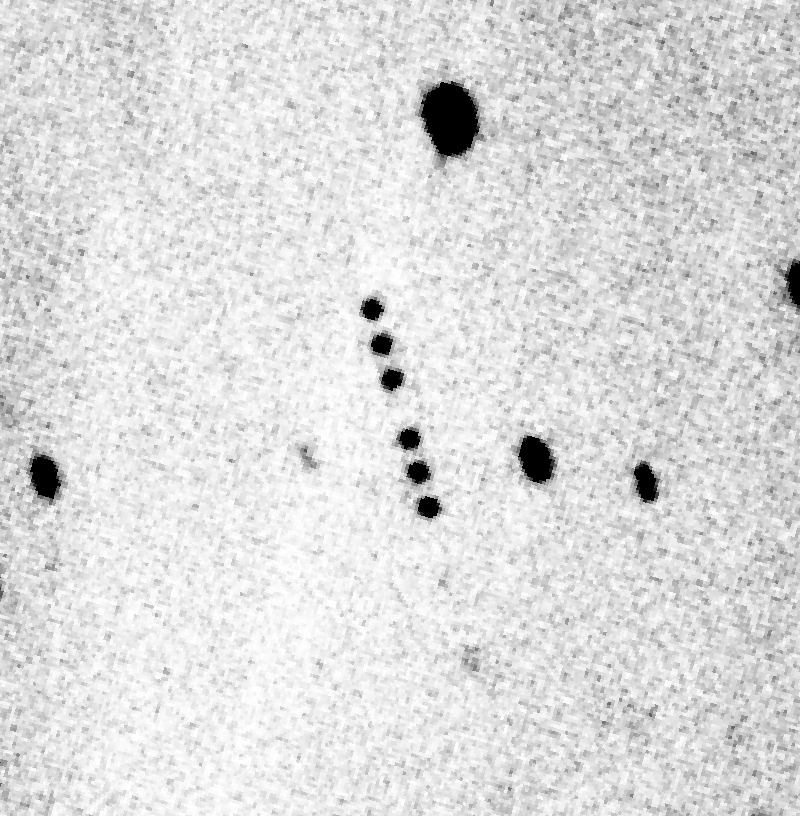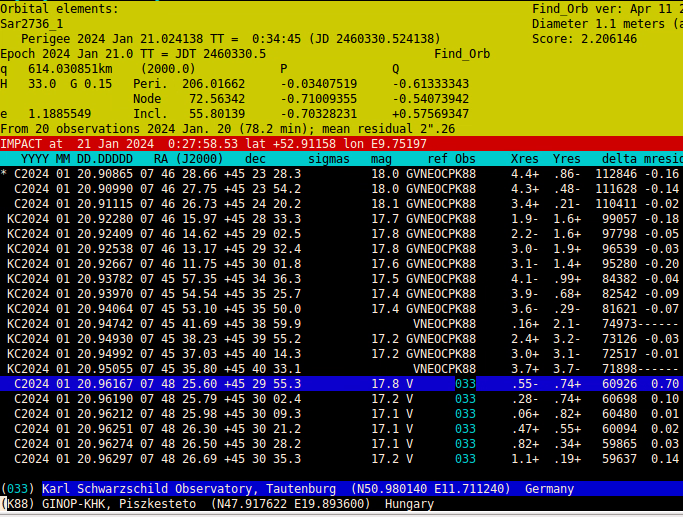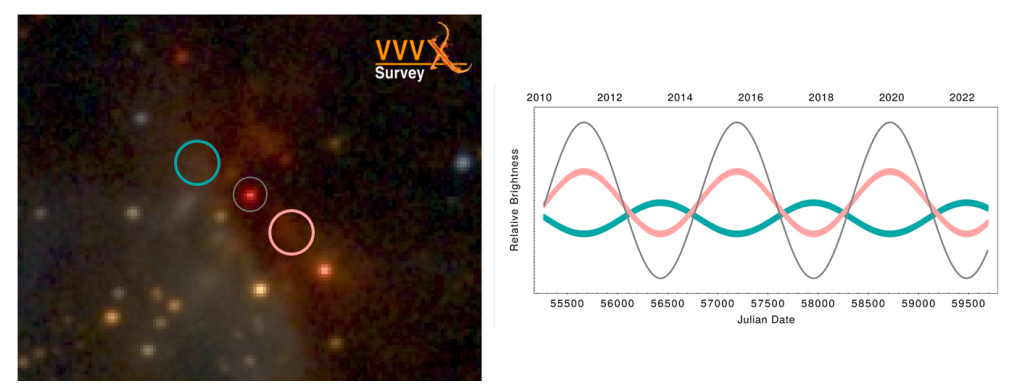A new method to observe winds on planet Jupiter
16.04.2024
A team of scientists managed to draw the first map of atmospheric circulation of the planet Jupiter with the Doppler method.
Jupiter, the largest planet in our solar system, is famous for its brownish-white storm bands and its large red spot. The wind bands race around the planet in an easterly and westerly direction and reach high speeds of up to 500 kilometers per hour. An international team of astronomers, including Patrick Gaulme, astronomer at the Thuringian State Observatory in Tautenburg, has now produced the first map of these winds using the Doppler method.
What wind speeds prevail on Jupiter? Until now, astronomers have used images of the gas planet's cloud structures taken at different time intervals to answer this question. They calculate the wind speeds from the changes in the images. However, this method has its limits. "The clouds change or disappear. This affects the measurements," explains François-Xavier Schmider, Research Director at the Observatoire de la Côte d'Azur (OCA) in France who led the research project.
Another difficulty: The images allow scientists to calculate the speed of the winds in an east-west or west-east direction, but give poor results in a north-south or south-north direction. The reason is, simply put: The bands on Jupiter have different altitudes, and clouds structures are separated from one band to the next. Also, cloud tracking cannot measure the vertical motion in a planet’s atmosphere. Therefore, it is not known, how heat and chemical elements are transported from the inside to the outside of the planet.
Measuring atmospheric circulation with the Doppler method
Instead of relying on cloud images of Jupiter, Schmider's research team uses the Doppler method to observe the atmospheric circulation of the gas planet. The Doppler effect can be used to measure how the frequency of a light or sound wave changes when its source moves relative to the observer. If the source moves towards the observer, the waves arrive at the observer at shorter intervals. If the source moves away, the distances between the waves increase.
Patrick Gaulme, scientist at the Thuringian State Observatory, is part of the international research team that observed the atmospheric circulation on the planet Jupiter using the Doppler method. He describes how the researchers proceeded: "A Doppler imager is mounted on each of three telescopes in Japan, in France and in the USA. Together, these telescopes form the JOVIAL network. The Doppler imager can be used to create an image of the planet together with its Doppler velocity map by tracking the displacement of the spectral lines of sunlight reflected from Jupiter." From the shift of the spectral lines, the speed of the atmospheric motions can be deduced.
After the team had observed for around 80 hours with the instrument at one of the three telescopes, the Dunn Solar Telescope in Sunspot, New Mexico, USA, the researchers were able to create a complete zonal velocity map of the planet Jupiter. This is the first time that such a map is obtained with such a technique for any of the giant planets. “It is stunning. I particularly enjoy seeing the great red spot standing apart. And more generally, watching something that no one has done before. Scientifically speaking, the zonal wind map shows an excellent agreement with results obtained by cloud tracking, which validates the technique, and allows us to move forward”, says Patrick Gaulme.
The team has published the results of its research in the scientific article "Three-dimensional atmospheric dynamics of Jupiter from ground-based Doppler imaging spectroscopy in the visible"in the The Planetary Science Journal. The preprint of the paper is accessible under this link: https://ui.adsabs.harvard.edu/abs/2023arXiv231216888S/abstract
|
A reconstructed image of Jupiter |
A zonal velocity map of Jupiter. The red and blue colors indicate the easterly and westerly winds, respectively. |
Both images were obtained from data recorded with the JOVIAL/JIVE instrument at the Dunn Solar Telescope in Sunspot, New Mexico.
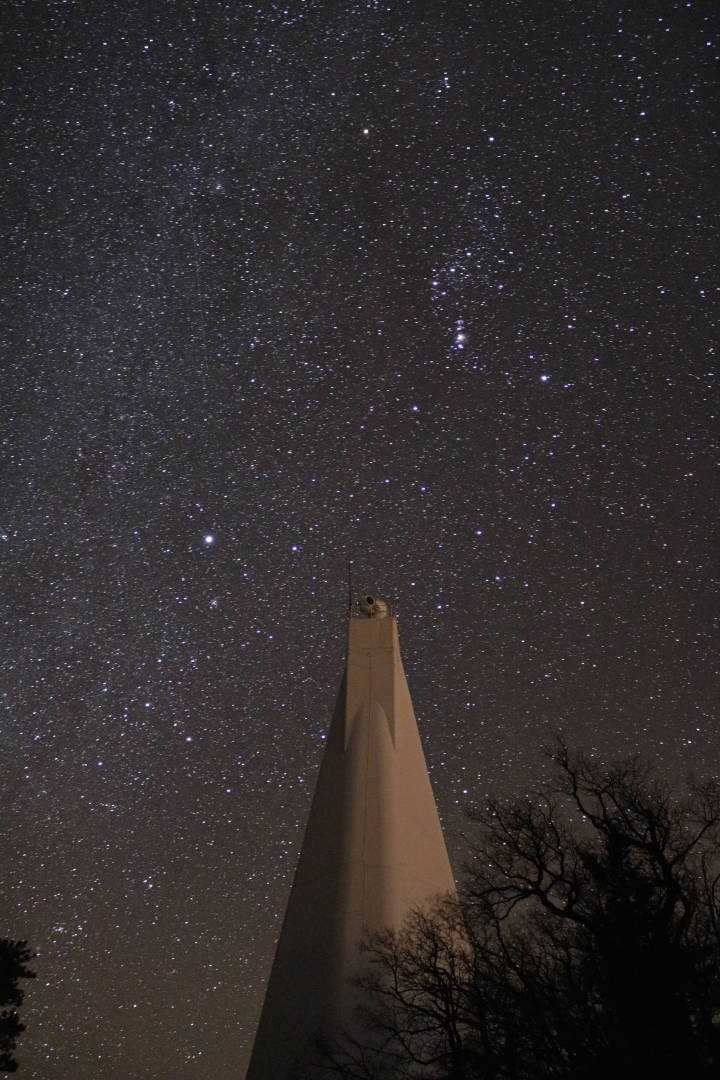
The Dunn Solar Telescope tower at Sunspot, New Mexico, @Patrick Gaulme, for editorial purposes only
The Thuringian State Observatory
The Thuringian State Observatory Tautenburg (TLS) is a research institute funded by the Free State of Thuringia, Germany. It conducts basic research in astrophysics. Researchers at TLS use various telescopes throughout the world for their observations of galaxies, stars, the sun, gamma ray bursts, and extrasolar planets.
The Thuringian State Observatory uses and operates the 2-meter Alfred Jensch Telescope for observations in the optical spectral range and a station of the European Low Frequency Array Radio Telescope (LOFAR). It is also building a solar lab to develop a prototype of an automated telescope for the continuous observation of the sun.
Contact
We are happy to answer your questions:
Bauhaus - Tautenburg: When Art Meets Science
08.04.2024
On February 22, we had the chance of welcoming PhD students in Art and Design from the Bauhaus University in Weimar, led by Prof. Alexandra Toland. The goal of this first meeting between the two Thuringian institutes was to know each other with the idea of fostering future collaborations between art students and scientists.
The visit started with a tour of the 2m-Alfred Jensch telescope by Eike Guenther and an explanation of the LOFAR radio telescope by Alexander Drabent. Then, roundtable conversations organized by Harriet von Froreich (Bauhaus U.) and Patrick Gaulme (TLS) gathered about 15 scientists and 10 art researchers to exchange ideas across disciplines regarding questions of time, distance, types of data, and the challenges and joys of developing methods in practicing research. The meeting was followed by a get together. Next visit is scheduled in June, hoping for clear skies to see the telescope at work during a short near-solstice night.
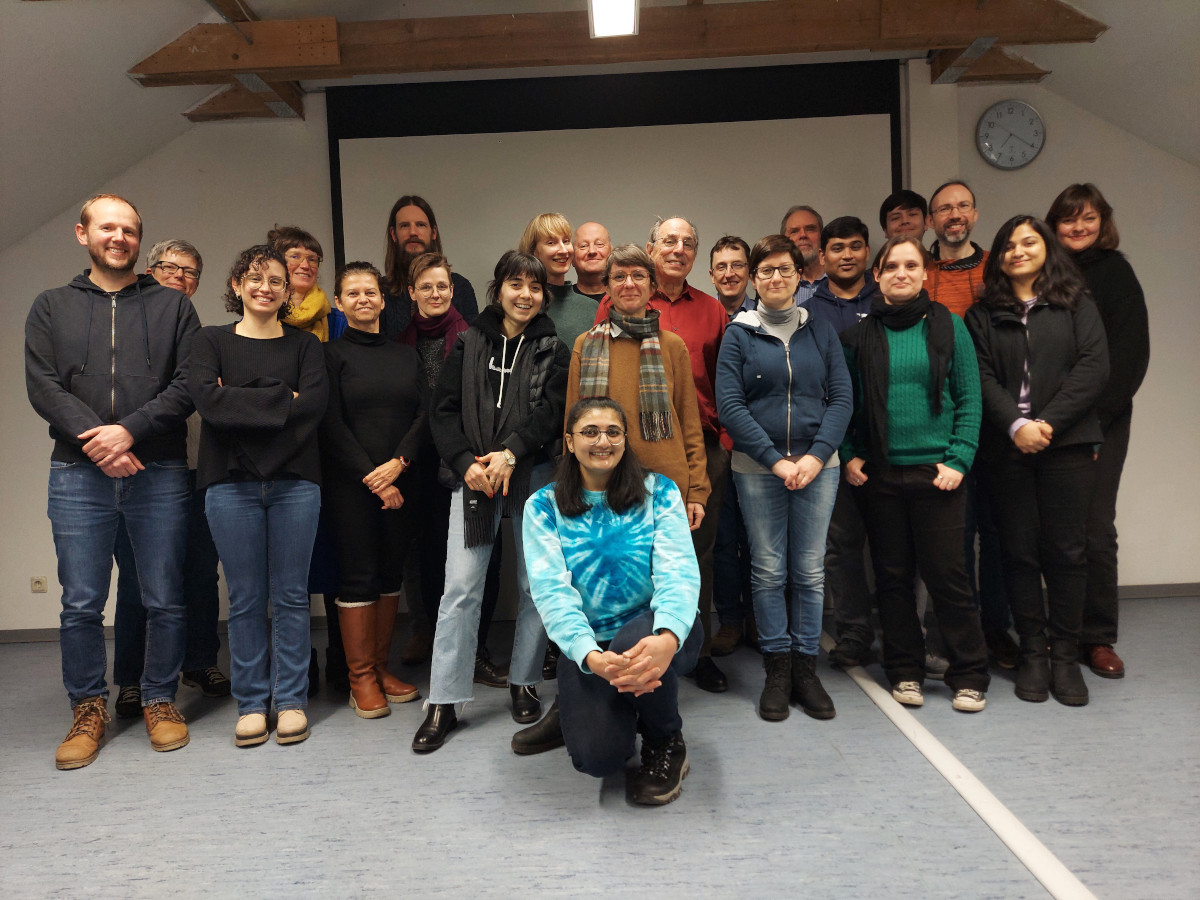
What solar physicists can learn from the solar eclipse.
10.04.2024
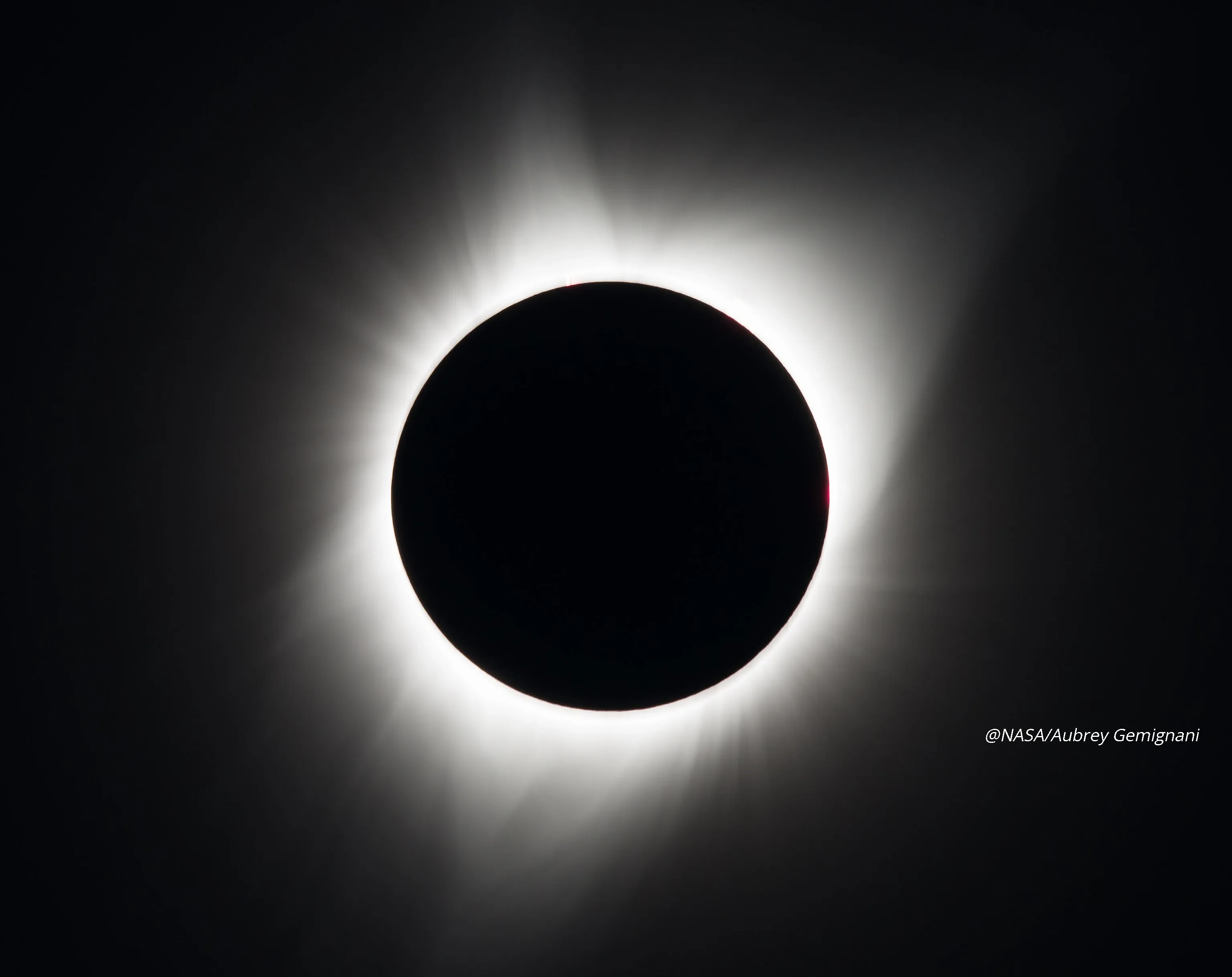
A total solar eclipse is a spectacular natural event. The moon moves between the sun and the earth, blocking our star. It gets dark in the middle of the day, and the night sky becomes visible. Millions of people will observe this event on April 8, 2024, in North America. Professor Dr. Markus Roth, Director of the Thuringian State Observatory, explains why the solar eclipse of 2024 is so special.
A total solar eclipse is an impressive natural spectacle. On April 8, 2024, the sun will darken in a roughly 180-kilometer-wide strip across Mexico, the United States, and Canada. Why is this solar eclipse so special?
| Markus Roth: After 2017, this solar eclipse is the second to occur on the North American continent in a short time. The solar eclipse on April 8 is visible in a wider strip than seven years ago. Additionally, the duration of the solar eclipse is between slightly over 3 minutes to 4.5 minutes, depending on the observation location, which is quite long. In comparison, the solar eclipse on August 11, 1999, visible in Germany, lasted just over two minutes. |
Source: FSU/Annegret Guenther |
Currently, the sun is at the peak of its activity. This means the probability of sunspots is quite high. Sunspots are strong magnetic field poles and occur particularly frequently every eleven years. Accordingly, the sun's corona, which becomes visible during a solar eclipse, could appear very structured.
Interestingly, the comet 12P/Pons-Brooks will also be in the daytime sky on April 8. Although it is too faint to be seen with the naked eye during the eclipse, it would be visible with a telescope. However, caution must be taken not to accidentally look into the sun with the telescope or binoculars.
Millions of people will observe the celestial spectacle and hope that the sun will provide a spectacular show. You are solar physicists. What scientific insights do researchers gain from such an event?
Roth: NASA will send the WB-57 high-altitude research aircraft along the path of the solar eclipse. A research project will capture images of the solar eclipse from an altitude of 50,000 feet above the Earth's surface. By capturing images above most of the Earth's atmosphere, researchers aim to discern new details of structures in the middle and lower corona. NASA's WB-57 will also carry instruments to learn more about the temperature and chemical composition of the corona and coronal mass ejections.
With modern solar telescopes and instruments, a solar eclipse can also be artificially and continuously produced, allowing the solar corona to be continuously studied. From such systematic studies, much can be learned, for example, about the physical processes that lead to coronal mass ejections on the sun, often also called solar storms.
What have scientists learned from previous solar eclipses?
Roth: In the past, an important insight was the confirmation of the general theory of relativity. In 1919, it was demonstrated that light from stars is deflected by the gravitational effect of the sun, as calculated by Albert Einstein beforehand.
Furthermore, in the past, solar eclipses have been used to determine the temperature, composition, and magnetic field in the solar corona. The corona is the outermost layer of the solar atmosphere, which is usually overwhelmed by the sun, meaning that measurements of these physical quantities were otherwise not possible.
What impact does a solar eclipse have on the Earth?
Roth: A solar eclipse has no noticeable impact on the Earth. There may be slight temperature changes due to the darkening. Also, it is expected that the animal world may react with surprise to the sudden onset of night.
Thuringian State Observatory Achieves Milestone in Construction of New Spectrograph PLATOSpec
06.04.2024
| The Thuringian State Observatory Tautenburg is part of a consortium building the high-resolution spectrograph PLATOSpec. This instrument will be mounted on a 1.52-meter telescope at the European Southern Observatory (ESO) in La Silla, Chile, during the course of 2024. An important milestone has now been reached for the project: a new front-end has been installed on the telescope, and the calibration unit has been installed. | 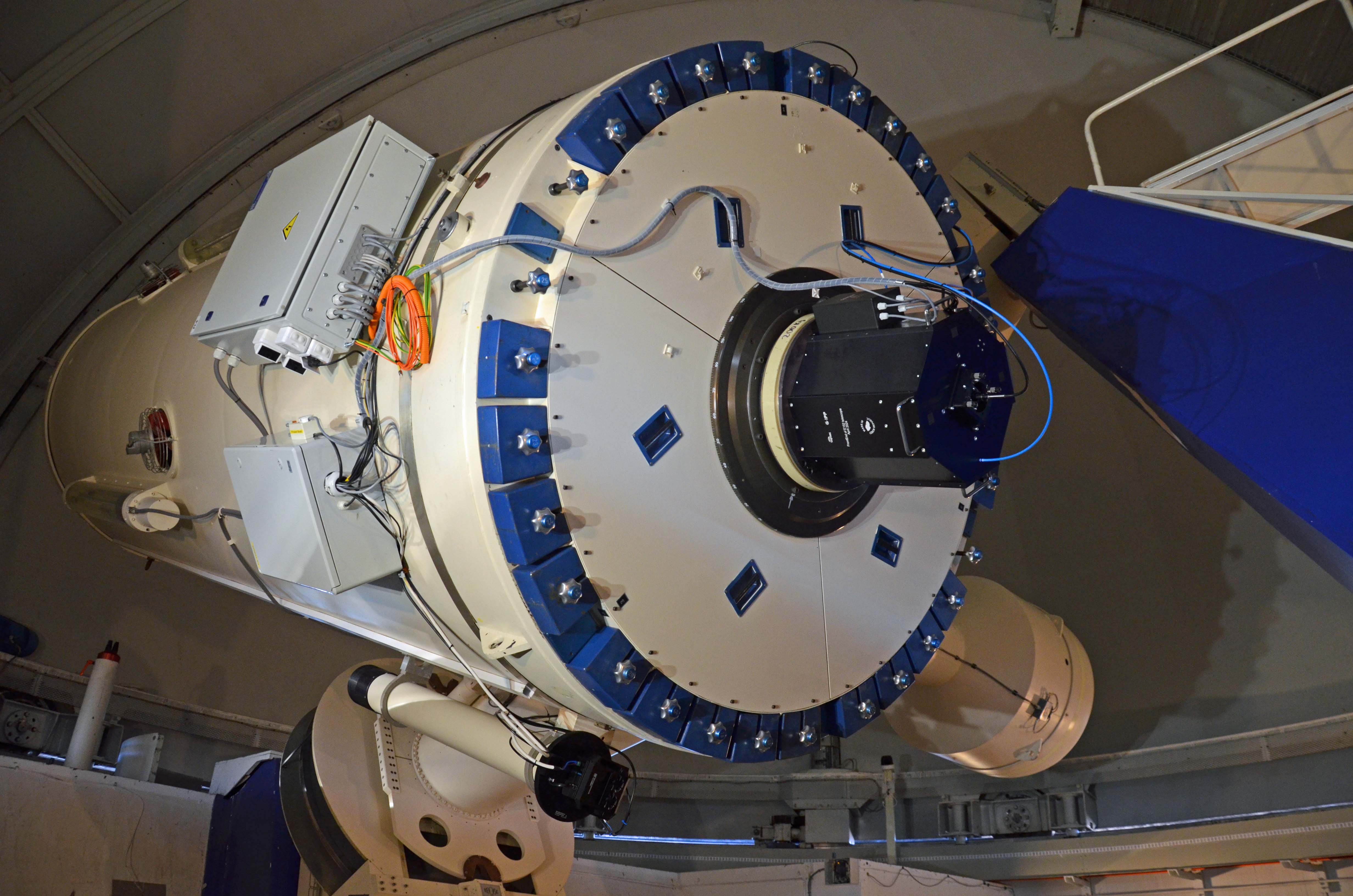 |
The workshops of the Thuringian State Observatory have developed, built, and tested the calibration unit for the spectrograph PLATOSpec. At the end of March 2024, it was mounted on the 1.52-meter telescope of the ESO in La Silla, Chile, together with a new front-end.
The calibration unit serves as a reference for the telescope's observations. For this purpose, the spectrum of a thorium-argon lamp is used, whose spectral lines are already known. The spectrograph PLATOSpec will desperse the starlight captured by the telescope into a spectrum. This spectrum is then compared with that of the thorium-argon lamp. This provides researchers with a wavelength reference point. Additionally, an iodine cell is used for calibration. With the spectrum produced by this iodine cell, the radial velocity (Doppler shift) of a star can be measured very accurately.
The front-end connects the spectrograph to the telescope. It was built by the Czech company TopTech, Turnov. The Thuringian State Observatory, as a partner of the PLATOSpec consortium, commissioned, supervised, and financed the construction of the front-end.
The calibration unit and the front-end are prerequisites for connecting the PLATOSpec instrument to the 1.52-meter telescope. The spectrograph PLATOSpec is still under construction. PLATOSpec will be a state-of-the-art echelle spectrograph with high spectral resolution, covering the spectral range from 350 to 700 nanometers. PLATOSpec will support satellite missions TESS and PLATO with ground-based follow-up observations. The aim of these missions is to find planets around stars other than the Sun, known as extrasolar planets.
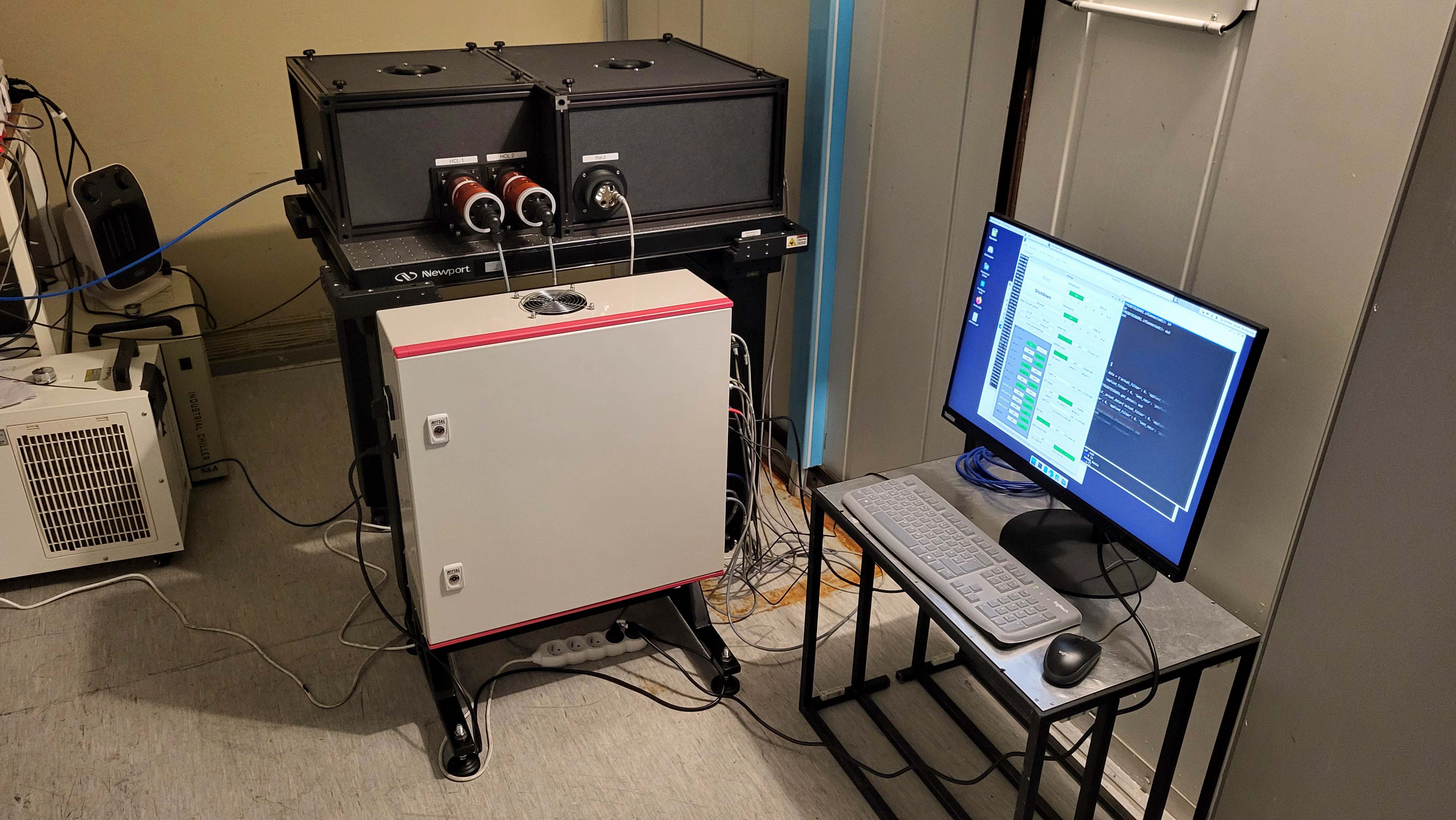 |
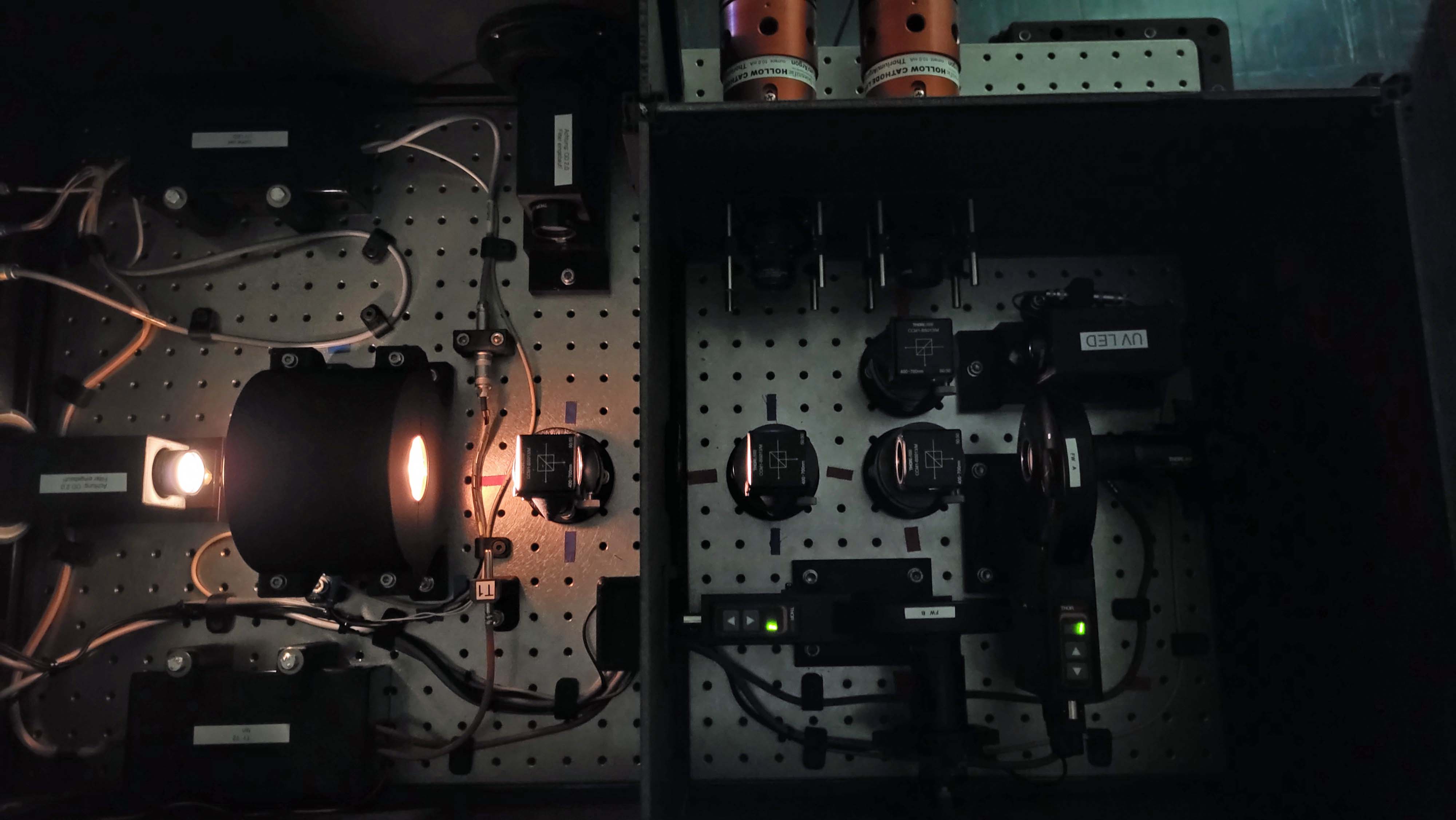 |
The PLATOSpec instrument is being built by a consortium of three institutes. The main partners of the consortium are the Astronomical Institute ASCR in Ondrejov, Czech Republic, the Thuringian State Observatory, Tautenburg, Germany, and the Pontificia Universidad Católica (PUC) de Chile, Santiago, Chile. The contribution of the Thuringian State Observatory to PLATOSpec was financed by the Thüringer Aufbaubank with funds from the research promotion program of the state of Thuringia.
Asteroid 2024 BX1 observed at the TLS shortly before its impact near Berlin
07.02.2024
The time around the full moon is actually not suitable for astrophotography. Nevertheless, the night of January 20th to 21st, 2024 had a surprise in store for Dr. Stanislav Melnikov and his colleagues. He carried out observations for the ``Near-Earth Asteroid program´´. The sky was already so bright that faint asteroids were barely visible. Thus, the researcher was pleased when a new object named Sar2736 suddenly appeared on the target list. Its brightness and speed suggested it was close to Earth. Dr. Bringfried Stecklum, who followed the measurements via the Internet and processed the images, advised him to quickly observe the object. However, the first attempt at around 11:30 p.m. failed. The replacement camera, which had to be used since TAUKAM was under repair, did not capture the asteroid with its smaller field of view. A little later more precise coordinates arrived and Dr. Melnikov tried again. This time he took six images, which were immediately evaluated (Fig. 1). An orbit is routinely calculated from the determined positions and those already known in order to detect false identifications and other problems. Dr. Stecklum became speechless when the FindOrb program used for this purpose predicted that the asteroid would hit Earth in about an hour (Fig. 2). In addition, the coordinates of the impact site suggested that this would happen in the northern central part of Germany. Normally, this would be a cause for concern, but in this case there was no reason for it. Using the typical reflectivity of asteroids and the measured brightness, FindOrb calculated a diameter of about one meter. For such a small object, part of the mass would burn up when it entered the atmosphere, and the rest would burst. Therefore, there was no danger. A third attempt to photograph Sar2736 with the TLS telescope was unsuccessful - the object was now traveling too fast. A little later there were first reports of the spectacular light phenomenon of a bolide or fireball that fell west of Berlin near Nennhausen (Havelland).
A total of 14 stations reported positions to the Minor Planet Center (MPC), which gave the object the official name 2024 BX1. The TLS was third in the order. 2024 BX1 is the eighth asteroid discovered within 24 hours of its impact. Its discoverer, Krisztián Sárneczky, from the Konkoly Observatory, had already identified two. Various search parties have now managed to find fragments of the asteroid (meteorites) (MAZ). These suggest that 2024 BX1 was not a primitive asteroid, but came from a body whose internal structure is similar to that of Earth. It may have split off from Vesta, the largest asteroid in the solar system. The rare finds promise valuable information about the history of the formation of the solar system.
|
Fig. 1: Superposition of the six TLS images. The telescope tracked the asteroid, therefore the stellar images are elongated. |
Fig. 2: Results of FindOrb, based on the discoverer positions (K88) and those of TLS (033). Impact time and coordinates were highlighted red. The size estimate is at the upper right. |
Obituary Professor Dr. Josef Solf
02.02.2024
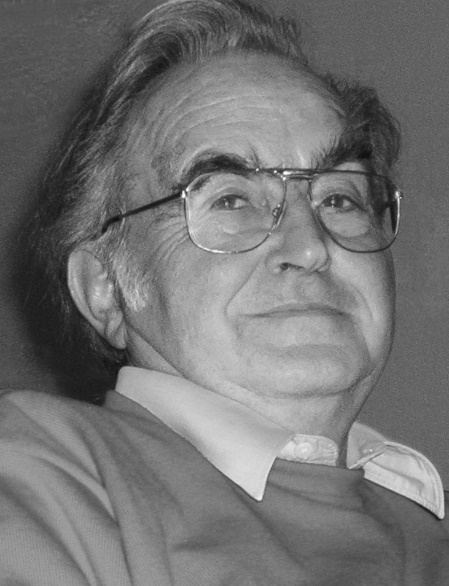 |
The Thuringian State Observatory mourns its former director Professor Dr. Josef Solf, who passed away on December 31, 2023, just a few weeks before his 90th birthday, in Jena. |
Josef Solf had a significant impact as a scientist and institute director in Heidelberg and Tautenburg. During his time in Heidelberg at the Max Planck Institute for Astronomy, he developed spectroscopic instrumentation for the telescopes at the newly emerging German-Spanish Astronomical Center on Calar Alto. With them, he achieved recognized scientific success in the field of bipolar phenomena in star formation and development. As director of the Thuringian State Observatory, he contributed to the expansion of the institute and the modernization of the 2-meter Alfred Jensch telescope and its instrumentation.
Josef Solf was born on February 5, 1934, in Worbis in the Eichsfeld region and grew up there with his five younger brothers in "Solf's Mill." His father was a very influential figure in his life. Early on, he sparked numerous interests in him – in mill technology, music, religion, photography, philosophy, and physics. He attended boarding school in Heiligenstadt, where he graduated in 1952 with a humanistic diploma. He then began studying mathematics at the University of Jena. Driven by his big question "Am I finished yet?" he changed direction and studied philosophy, theology, and art history from 1953 to 1962 at the Jesuit universities in Berlin, Frankfurt, and Munich. As his question remained unanswered and the curiosity to discover the world was inherent in him, he changed his career path again in 1962 and began studying mathematics, physics, and astronomy – first in Karlsruhe, then in Heidelberg, where he graduated in 1967 with a degree in physics. He completed his PhD in nuclear physics there in 1969.
From 1969 to 1994, Josef Solf worked as one of the first scientific employees at the newly founded Max Planck Institute for Astronomy in Heidelberg, dedicating himself to the development of astronomical instruments and the study of star development.
He played a crucial role in establishing the institute's new observatory at Calar Alto in southern Spain. His focus soon turned to the development of spectroscopic instrumentation for the new telescopes. He gained knowledge during research stays at the Lick Observatory in California in 1971 and 1974, among others. A significant achievement was the Coudé spectrograph for the 2.2-meter telescope, a vertical setup through the entire dome building, which relied on a single mirror outside the telescope and undoubtedly represents one of the most powerful instruments of its kind. As a similar device promised no greater efficiency for the 3.5-meter telescope, interest there focused on a large Cassegrain spectrograph. Together with the institute's co-director, Guido Münch, Josef Solf developed the TWIN spectrograph, which became one of the workhorses at this telescope for a long time. He also converted a standard Boller & Chivens spectrograph according to his own design into a unique "echelle" spectrograph, which allowed imaging the entire spectral range from UV to near-infrared with a single exposure.
The commissioning and initial use of these devices made Josef Solf an observing astronomer. Initially, he observed late M-stars and Mira variables. His long-slit, high-spectral-resolution images of the prototypical massive star S106, together with Uri Carsenty, first revealed the blue and red shifts of the gas in its opposing extended shells, convincingly demonstrating the bipolar structure of these objects. This was followed by studies of bipolar outflows and jets from evolved stars such as R Aqr and the nova HR Delphini, which he also made the subject of his habilitation thesis in 1983, as well as work on bipolar planetary nebulae with his doctoral student Luis Felipe Miranda. He then turned to detailed spectroscopic studies of bipolar outflows and Herbig-Haro jets from young stars and their bow shocks together with Karl-Heinz Böhm. The method of spectro-astrometry that he developed to study these jets near the source was and is so successful that it was sometimes called "Solf's method" by some. In 1990, the University of Heidelberg appointed Josef Solf as a professor.
When Josef Solf received a call to a professorship in astronomy at the Friedrich Schiller University of Jena in 1994, combined with the position of director of the Thuringian State Observatory in Tautenburg, he returned to Jena, which he had left as a student in 1953. As a member of the Faculty of Physics and Astronomy, he was involved in teaching and scientific training of students until his retirement in 1999. As director of the Thuringian State Observatory Tautenburg, he contributed to the expansion of the institute and the modernization of the 2-meter Alfred Jensch telescope and its instrumentation. The construction of a new research building provided much-needed space for workrooms for scientists and administration. Laboratory space was also created for the electronics lab, as well as climate-controlled rooms for archiving the extensive collection of photographic plates of the Thuringian State Observatory and for their digital processing. An important concern for Josef Solf was the modernization of the 2-meter Alfred Jensch telescope, the largest optical telescope on German soil, which, through the renewal of its drives, enabled digital control. He designed the conversion of the high-resolution Coudé spectrograph into a Coudé echelle spectrograph, with vastly increased wavelength coverage, and conceived a low-resolution spectrograph for the Nasmyth focus of the telescope. With the active support of his former institute, the Max Planck Institute for Astronomy in Heidelberg, all focus stations received powerful CCD cameras as detectors.
After his retirement, Josef Solf remained active in the Catholic church choir in Jena. For many years, he was involved in the hospice association, accompanying numerous people in their darkest hours. He had three sons with his beloved wife Gisela, who passed away in 2017.
The Thuringian State Observatory has not only lost its former director and an outstanding scientist with Josef Solf but also a modest, energetic, and highly esteemed colleague. It will preserve his memory with honor.
Container laboratory weighing 5 tons floats to its destination
31.01.2024
The container for the future TauSol solar laboratory at the Thuringian State Observatory has been placed on a special foundation.
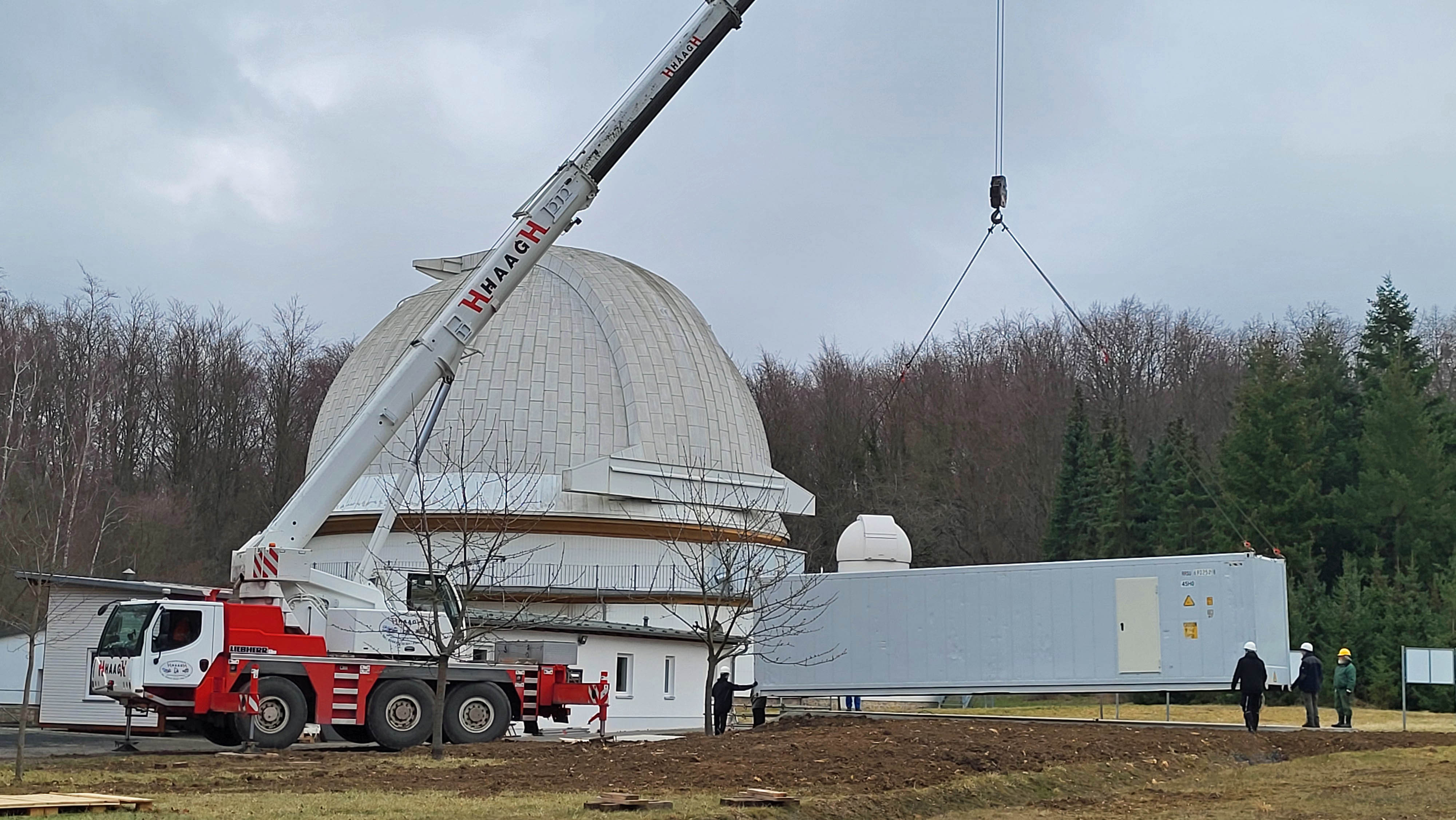
On Wednesday morning, January 31, 2024, at 8:30 a.m. the time had come. After the foundation for the new TauSol solar laboratory was completed before Christmas, the weather and then the observatory's schedule did not play along at the beginning of the year. But this week the clayey ground had dried out and the weather was stable, so that the heavy mobile crane from Dorndorf was able to arrive. As the distance to the foundation was initially too great, the 12 m long and 5 ton container had to be parked once so that the truck-mounted crane could then lift the container onto the foundation from a position closer to the foundation on the second attempt. Accompanied and guided by the observatory's technical team, the container finally touched down in the specified position with almost millimeter precision - precision landing! Now the interior work and the installation of the dome above the container can begin. But first the container will get a new coat of paint - if the weather cooperates again.
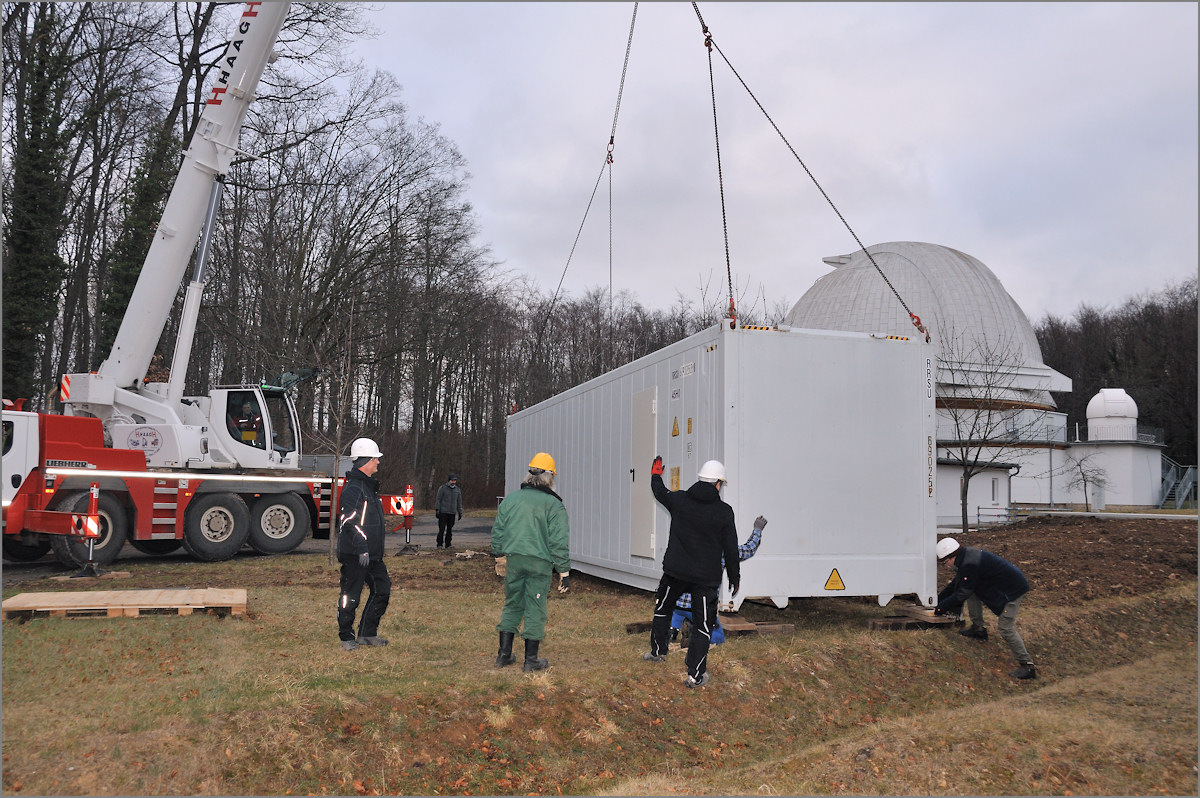 |
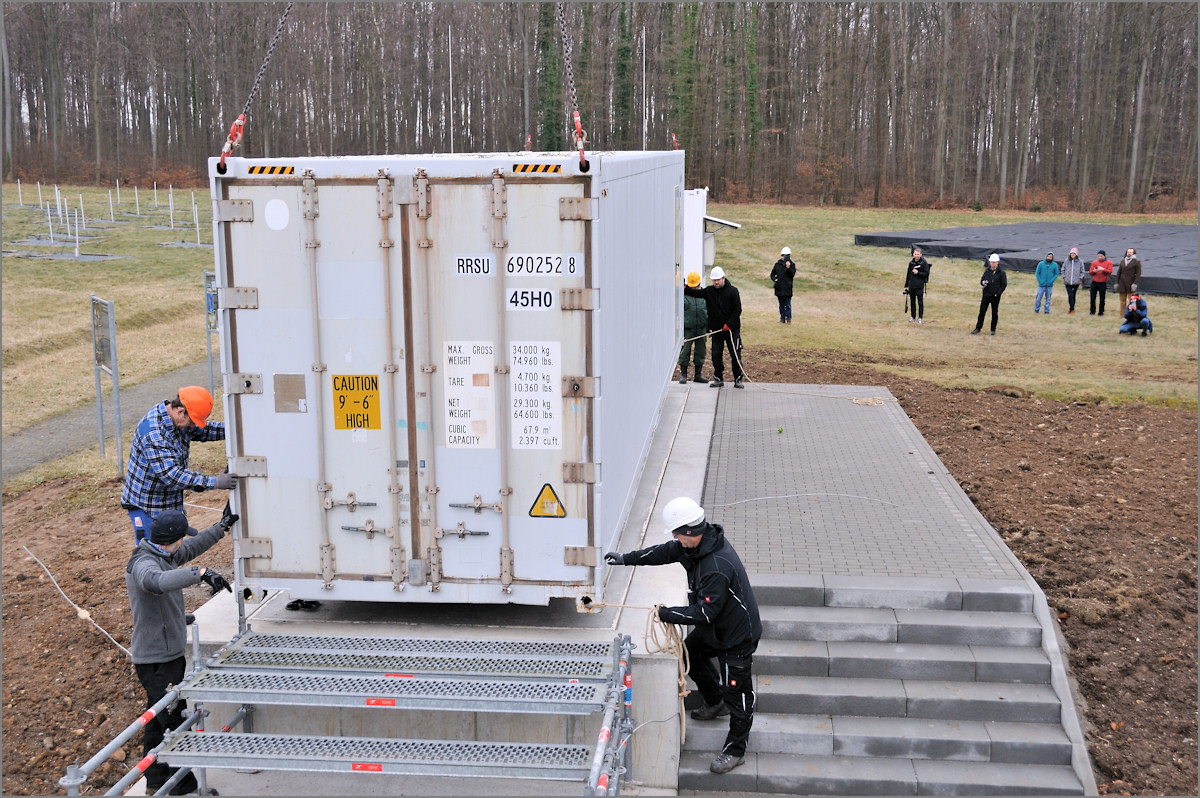 |
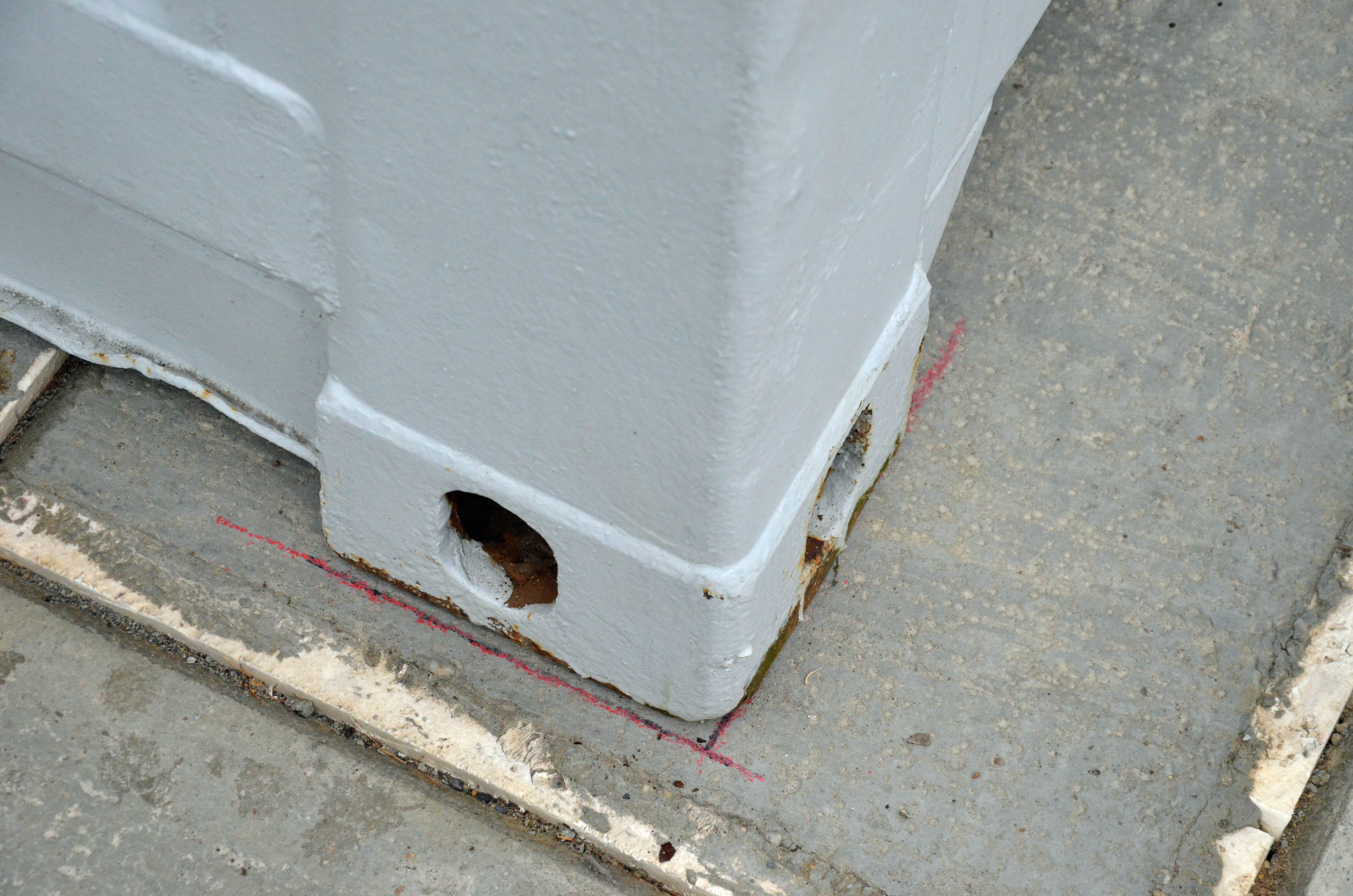 |
A nebula beating at the rhythm of its newborn star
26.11.2023
An international team of astronomers lead by Prof. Roberto K. Saito of the Universidade Federal de Santa Catarina in Florianópolis, Brasil, reports the discovery of a unique object in our Galaxy. This object is located in the Scorpio constellation, close to the center of the Milky Way. It is observed as a peculiar combination of a variable star surrounded by a nebula that is also changing brightness. This discovery has been published on 2023 November 14 in The Astrophysical Journal Letters.
The discovery is made thanks to the VVV survey, that systematically mapped the Milky Way plane in the infrared with the VISTA telescope at ESO Paranal Observatory in Chile. The deep images accumulated along more than 12 years allow searching and monitor stars that change brightness with time. Tens of thousands of variable stars were discovered, that are classified according to their light curves. However, occasionally some object appears that cannot be easily explained because they do not belong to any of the known classes.
The VVV survey found a dozen such unidentified objects, that are called WIT, for “What Is This?”, and that represent very rare astrophysical phenomena. Such is the case of WIT-12, that was discovered in the infrared images using a simple technique that is generally applied to search for supernova light echoes. This technique consists of making color images using different observation epochs in the same filter. In this case the search was made using the images obtained in years 2010, 2011 and 2012 revealed a nebula that changes color, suggesting an interesting kind of variability. The follow-up study of the region revealed a red star located in the center of the nebula that changes brightness with a period of about 4 years. Follow-up spectroscopic observations made with the 4-m telescope SOAR at Cerro Pachón in Chile revealed that this central source is a very young stellar object that periodically illuminates the nebula. But the mystery does not end there, because the study that took so many years also revealed that the nebula changes brightness, and that one part varies in synch with the star, while the other part varies out of synch. That is, when the central star gets brighter, that part of the nebula fades.
This is an unknown phenomenon that perplexes the observers, motivating its classification as a WIT object, although the VVV team proposes a couple of explanations. This could be a central variable star that produces a light echo that reflects in the back part of the surrounding nebula. As the nebula is so extended, the light from the near side arrives directly to us, that region brightens when the star is brighter. On the other hand, the light that reflects on the more distant region of the nebula takes some time to travel, so it arrives later when the star is dimming. This phenomenon known as a light echo has been observed before in a few explosive events like novae and supernovae, but not in variable stars like WIT-12. Another possible explanation is the presence of a warped circumstellar disk that blocks light to different parts of the nebula as the warp moves around the star. This might be described as an "anti-light house", that illuminates all directions except one, in rotation. The final solution demands more observations and a new search for these kinds of objects, using telescopes like the future Vera C. Rubin Observatory.
The figure shows on the left the central star and two regions of the nebula encircled. Schematic light curves are displayed on the right, with colors corresponding to those on the left. While one region (red circle) is in phase with the stellar variability, the other one (cyan circle) is out of phase.
Contact: Dr. Bringfried Stecklum
Delivery of the TauSoL laboratory container
16.11.2023
On November 15 the "40-foot container" (approx. 12m long) for the new Tautenburg solar laboratory TauSol was delivered to the Thuringian State Observatory by a special truck. Until the foundation is completed, on which the container will be placed together with the beam frame for a dome and the heliostat, the container is now standing at the edge of the LOFAR radio telescope, where the interior work will begin.
 |
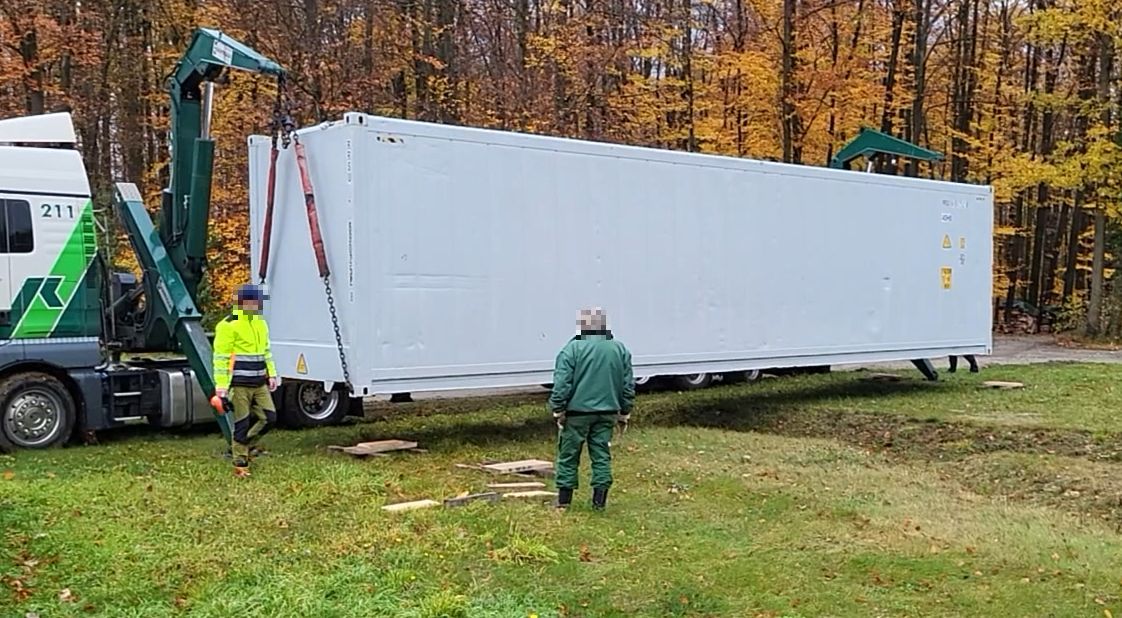 |
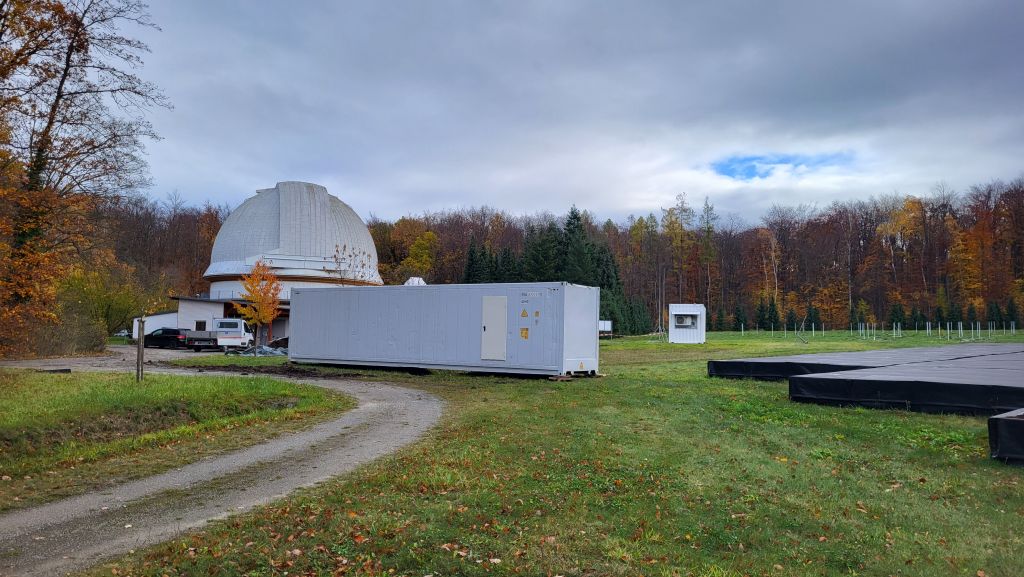 |
Images: TLS
A new optics lab at TLS
11.12.2023
Today the first optical tables were set up in the new optics laboratory at the Thuringian State Observatory.
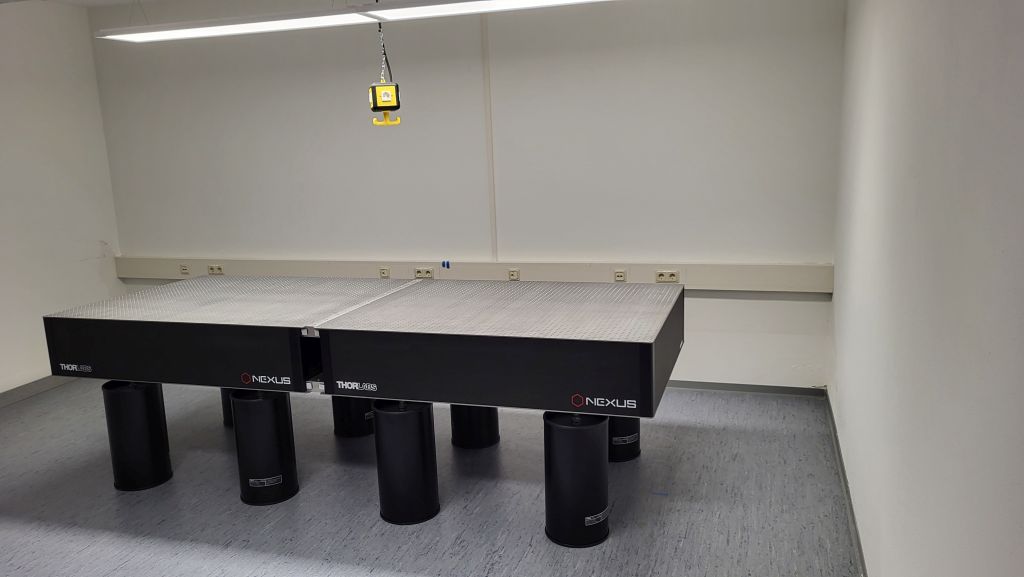
(Image: TLS)
In order to meet the growing demand for the development of new optical instruments at the TLS, a new optics laboratory is being set up. To this end, a basement room in the observatory's main building has been renovated over the past few months and equipped with new ventilation and electrical installations. Today the time had come and the first 3 m x 1.2 m optics table was set up. As it was not possible to transport such a large single table weighing around 600 kg into the cellar, it was assembled from two smaller parts weighing "only" 300 kg. But this transport also required skill, prudence and above all muscle power, which was provided by 6 employees of a Jena removal company. The first items to be measured in the new laboratory are special liquid crystal retarders for the observatory's new solar laboratory.
Image of the partial lunar eclipse
09.11.2023
On Saturday evening, October 28. 2023, a partial lunar eclipse occured, that could be observed through some clouds in Thuringia.
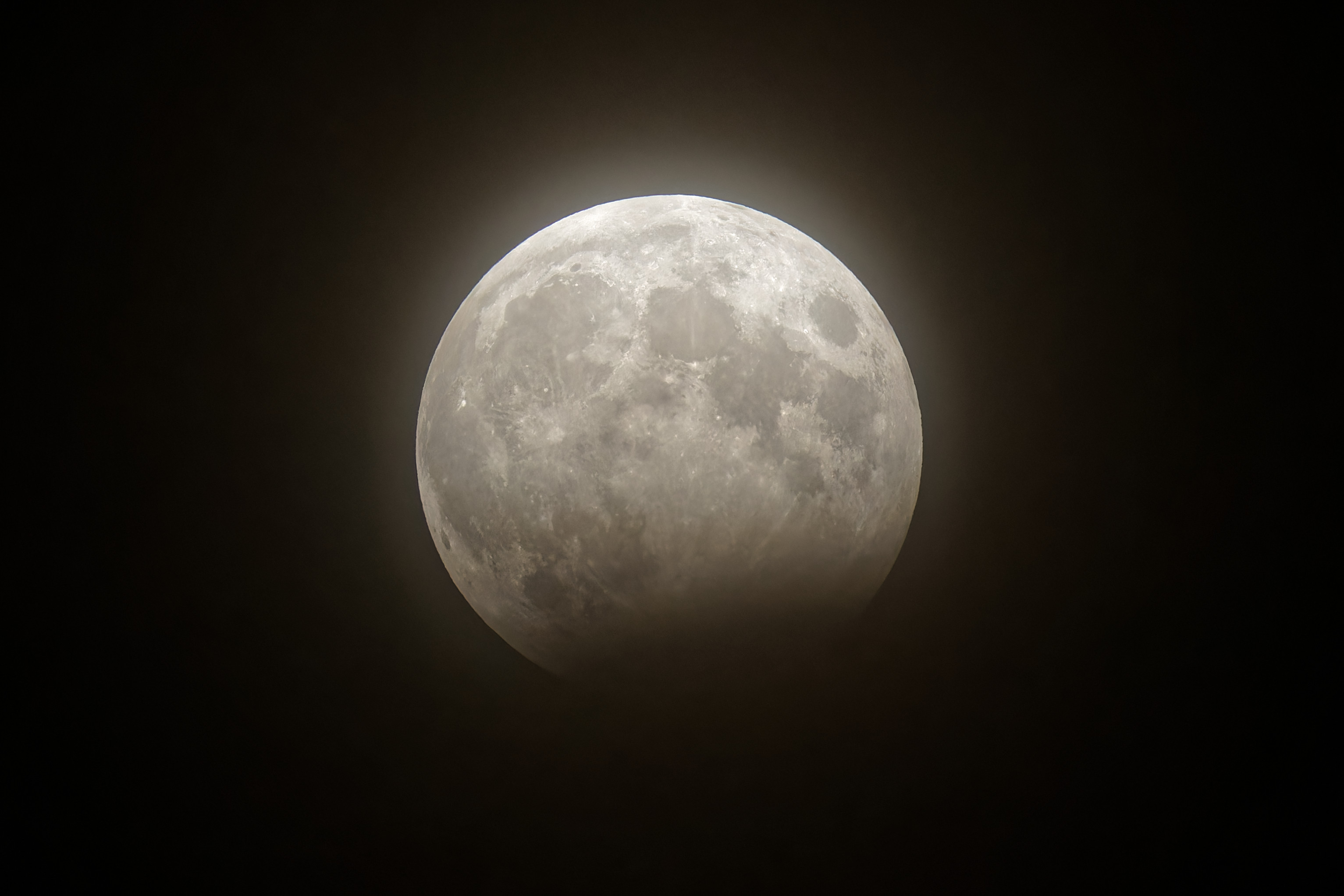
The photo taken by TLS is showing the eclipse at 22h22 CEST.
Thuringian astronomers confirm an unusual extrasolar planet
28.11.2023
Astronomers at the Thuringian State Observatory and the University of Turin have succeeded in extracting some of the secrets of an unusual extrasolar planet.
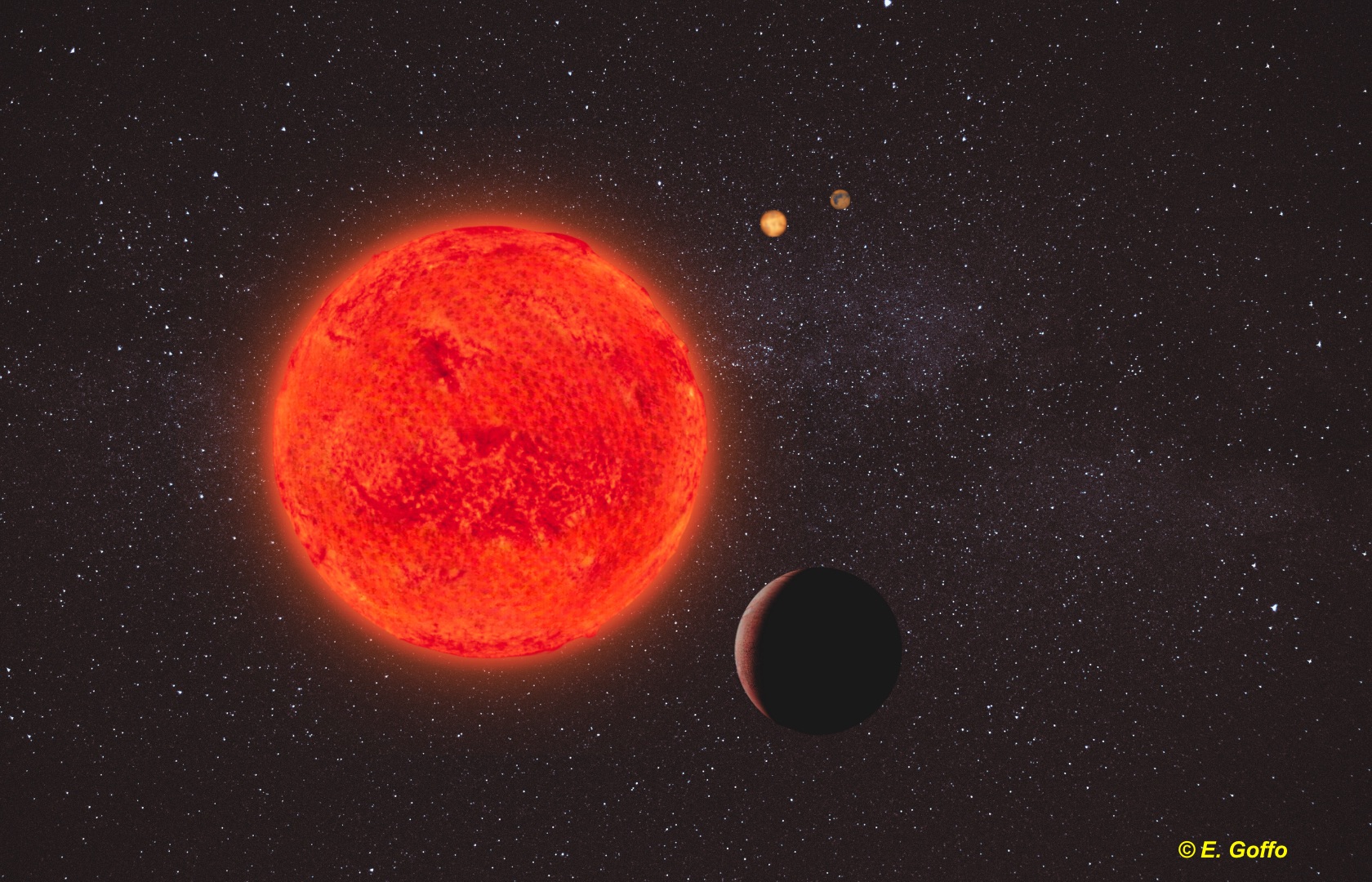
The extrasolar planet GJ 367 b is exceptional because it appears to be entirely made of iron. It orbits its central star in just 7.7 hours. Researchers were not only able to determine the planet's density but also discovered two more planets around the star during their observations. This discovery adds another piece to the puzzle of how planets form.




